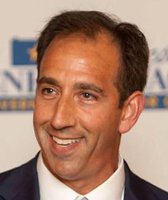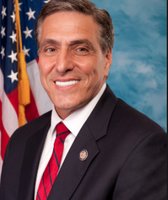Get PolitiFact in your inbox.

Democrat Conor Lamb is pictured on the campaign trail.
In a new televised ad, Republican Congressman Keith Rothfus says his Democratic opponent for Pennsylvania’s new 17th Congressional District, Rep. Conor Lamb, supported taking billions from Medicare — while also voting to use federal funds to protect a threatened species of mouse.
"Who’s Conor Lamb protecting?" the ad asks. "Not seniors. Lamb supports a program that took billions from Medicare. Not the sick. Lamb wants to keep higher taxes on prescriptions and insurance. Not families. Lamb voted to protect criminals hiding in sanctuary cities."
"Who is Conor Lamb protecting?" the narrator then asks. "A mouse. Lamb voted to spend tax dollars to protect mice. Seriously."
We decided to mouse around and vet the claims for ourselves. Here’s what we found.
The mouse
Lamb and almost every other Democrat in the House voted in July against a measure that would end the use of taxpayer funds to implement or enforce the threatened species listing of the Preble’s meadow jumping field mouse.
The measure was introduced by Republican Rep. Doug Lamborn of Colorado. The mouse is a species native to Colorado and Wyoming and was first listed as threatened under the Endangered Species Act in 1998.
In introducing his amendment, Lamborn said, "Up until now, using this designation has been a costly burden to economic developments efforts."
But what about taxpayers?
According to expenditure reports, federal and state governments spent more than $390,000 protecting the Preble’s field mouse in 2016, the most recent year for which the data are available.
The mouse’s ESA designation has certainly been controversial in Colorado, where it’s been blamed for delays in flood recovery efforts and scorned by landowners and developers.
Earlier this year, the Fish and Wildlife Agency rejected a petition filed by homebuilders and ranchers who argued the mouse shouldn't be protected because it "isn’t a distinct subspecies but is essentially the same as other, more plentiful mice." Opponents say the mouse’s ESA protections result in costly and unnecessary restrictions on land use.
Rothfus voted for Lamborn’s amendment to prohibit the use of funds to implement or enforce the threatened species listing of the Preble’s meadow jumping mouse. The measure ultimately passed 213 to 202 on its way to being added as a restriction to the Interior Department’s budget. The department oversees appropriations for ESA enforcement arms like the Fish and Wildlife Service. The budget process continues and the Lamborn amendment is not yet officially on the books.
Lamb's team said he saw the vote as a partisan attempt to undermine the Endangered Species Act.
On Rothfus’ behalf, campaign spokesman Mike Barley said, "Despite this support and bad votes, Lamb is working overtime to get the mouse vote, voting to use tax dollars to protect mice. This is exactly the type of wasteful spending we can expect more of from liberal Conor Lamb if he is re-elected to Congress."
Barley did not respond to a follow up email asking why Rothfus voted "yes" on the Lamborn amendment.
In summary: Yes, Lamb voted against a measure that would have stopped the use of taxpayer funds to implement or enforce the threatened species listing of the Preble’s meadow jumping field mouse. By voting against the measure, Lamb effectively supported the continued use of taxpayer funds for that purpose.
Medicare cuts
Rothfus’ claim that Lamb supported the mouse over Medicare is more complicated. It hinges on Lamb’s support for the Affordable Care Act. And Lamb definitely supports the ACA — he’s said it’s "provided affordable coverage to more than a million Pennsylvanians who were previously uninsured."
Republicans and ACA opponents have long argued that the ACA amounts to a giant Medicare cut. (In 2012, two years after the ACA became law, PolitiFact called it the "talking point that won’t die.")
And it’s true, with an important caveat or two.
According to the nonpartisan Congressional Budget Office, Medicare spending would be reduced by $716 billion under the ACA by 2020, mainly because the law puts the brakes on annual increases in Medicare reimbursements for Medicare Advantage, hospital costs, home health services, hospices and skilled nursing services.
But Medicare spending is still growing, just more slowly than it would without the ACA, AARP reported.
Additionally, the Kaiser Family Foundation reports that part of the $716 billion projected reduction in Medicare spending owes to greater programmatic efficiencies put in place under the law.
Another factor? An influx of younger, healthier beneficiaries that has contributed to lower per capita spending and a slower rate of growth in overall Medicare program spending, per the KFF. In 2017, the KFF said Medicare benefit payments totaled $702 billion, up from $425 billion a decade earlier.
It’s also worth noting, as the Washington Post previously reported, that the Medicare spending reductions are mostly wrung from healthcare providers, not Medicare beneficiaries, although some argue that reductions impacting providers are bound to impact patients and services to some degree.
"The Affordable Care Act rolls back payment rates for hospitals and insurers," the paper reported. "It does not, however, change the basket of benefits that patients have access to."
In summary: Rothfus’ claims that Lamb’s support for the ACA equals his support for Medicare cuts misrepresents the research on this issue. Medicare spending is projected to decrease under the ACA by hundreds of billions of dollars, but only from where it would have been with annual increases in Medicare reimbursements still in place. Medicare spending is in fact still growing, albeit more slowly than it would have without the law.
Higher taxes on prescriptions and insurance
Rothfus’ claim that Lamb supports higher taxes on prescriptions and insurance also traces back to Lamb’s support for the ACA.
The healthcare reform law does include a prescription drug fee imposed on drug manufacturers, one that’s calculated based on their share of branded prescription drug sales. It’s an excise tax put in place to help fund the federal government’s expanded role in healthcare under the ACA. (The fee was projected to provide $27 billion in revenue over 10 years. The pharmaceutical industry makes hundreds of billions of dollars in revenue annually. The industry also anticipated "$10 billion and $35 billion in additional profits" as a direct result of the Affordable Care Act bringing insurance coverage to millions of previously uninsured Americans.)
But while some have linked the tax to rising drug costs, it’s also not the only factor at play. Others include Medicare’s inability, under current regulations, to directly negotiate drug prices, which could bring those prices down. Another likely factor, experts say, is the lengthy patent periods that allow one version of a drug on the market for years at a time, protecting manufacturers from generic competition but also allowing those manufacturers to run the table on pricing. The U.S. Government Accountability Office says the amount of money people spend on prescription drugs has nearly doubled since the 1990s and linked much of that increase to the use of expensive brand-name drugs and limited competition.
In summary: Yes, there are taxes imposed on prescription drug makers under the ACA, but it's unclear to what extent those taxes are trickling down to consumers or contributing to rising drug costs in general.
Mike Barley, a spokesman for Rothfus’ campaign, said the "higher taxes" reference in Rothfus’ attack ad is also a nod to those taxes imposed or increased directly through the ACA.
Indeed there were a number of those meant to help defray the costs of the program. They include the penalties meant to persuade individuals to buy insurance — the so-called individual mandate — and those meant to encourage employers to sponsor adequate plans for workers. They also include subsidies to help low- and middle-income Americans afford insurance on government exchanges. (Lamb supported the ACA’s individual mandate, which Republicans repealed under President Donald Trump.)
According to the centrist Urban-Brookings Tax Policy Center, the net effect of these tax levies is actually a greater burden for wealthier families and a reduced burden for poorer ones.
"Taken together, they increase the average tax burden significantly for families in the top one percent of the income distribution but benefit families in the bottom income quintiles by providing new credits that on average exceed new taxes for those families. [...] On net, the ACA significantly increased average taxes on families in the top one percent of income, cut taxes on families in the bottom quintiles, and modestly increased taxes on the rest of families."
In summary: Rothfus’ ad fails to note the gray area and variability in ACA-related tax hikes.
Sanctuary cities
Lamb did vote against a Republican-led bill earlier this year that would have cut funding to so-called sanctuary cities.
The "Securing America’s Future Act of 2018" was defeated by opposition from 193 Democrats, Lamb included, and 41 Republicans.
Rothfus was among the 193 House Republicans that voted in favor of the bill that included a provision withholding Homeland Security and Department of Justice funding from so-called sanctuary states or sanctuary cities that refuse to cooperate with federal immigration authorities.
In explaining Lamb’s vote, a spokesperson said, "Instead of taking up a bipartisan bill to protect Dreamers and make smart border security investments, Republican leaders held a vote on an extreme partisan bill that failed to do either. That’s why Conor voted against it, that’s why many Republicans voted against it, and that’s why it didn’t pass."
In summary: Yes, Lamb voted against a Republican-led bill to defund so-called sanctuary cities and states. His office certainly disagrees with Rothfus’ assessment of this vote as one in favor of "protecting criminals."
Our Sources
Phone, email interviews, Mike Barley, spokesman Rothfus for Congress, Sept. 18, 2018
Phone, email interviews, various Conor Lamb campaign representatives, Sept. 18, 2018
Email, Brian Hires, U.S. Fish and Wildlife Service, Sept. 19, 2018
Blog entry, "Lamborn Votes to Delist the Preble's Meadow Jumping Mouse in Colorado," lamborn.house.gov, July 18, 2018
Blog entry, "Federal and State Endangered and Threatened Species Expenditures, Fiscal Year 2016," U.S. Fish and Wildlife Service
Blog entry, "Colorado Flood Recovery Efforts Not Delayed by Preble’s Meadow Jumping Mouse," U.S. Fish and Wildlife Service, Feb. 5, 2014
Blog entry, "The Facts on Medicare Spending and Financing," The Henry J. Kaiser Family Foundation, June 22, 2018
Blog entry, "Is Your Medicare Safe?" AARP, January 2014
Blog entry, "Profits, Research and Development Spending, and Merger and Acquisition Deals," U.S. Government Accountability Office, Nov. 17, 2017
Blog entry, "Annual Fee on Branded Prescription Drug Manufacturers and Importers," IRS.gov
Blog entry, "Affordable Care Act Taxes," Urban-Brookings Tax Policy Center, Feb. 9, 2017
News article, "Mouse found in Colorado, Wyoming remains on protected list," Associated Press, April 16, 2018
News article, "Conor Lamb decisively won the health care vote in the Pennsylvania special election," Vox.com, Mar 14, 2018
News article, "Medicare 'cuts' and a talking point that won't die," PolitiFact, Nov. 2, 2012
News article, "Do Democrats have a ‘plan’ to cut Medicare spending by $800 billion?" Washington Post, Aug. 4, 2018
News article, "Obamacare Will Bring Drug Industry $35 Billion In Profits," Forbes, May 25, 2013

































